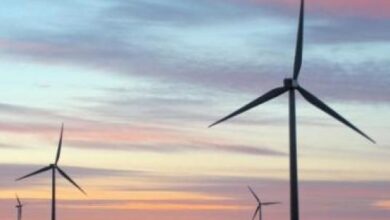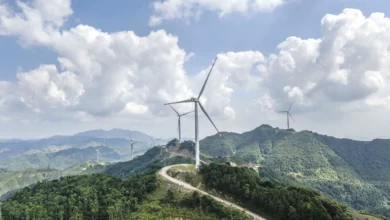
Egypt hopes to harness the wind to help meet its soaring demand for energy, but plans to build a network of wind farms near Gebel al-Zeit on the Red Sea coast have rankled avian conservationists. They fear wind turbines positioned at this geographical choke point could injure or kill untold numbers of migratory birds.
“It’s unfortunate, but the area in Egypt with the highest wind speed is also a bottleneck in one of the world’s biggest bird migration routes,” says environmental consultant Mindy Baha al-Din. “If they create a ‘great wall’ of wind turbines near Gebel al-Zeit, as they did at Zafarana further north, thousands of birds could be killed every year.”
Egypt currently has 550 megawatts (MW) of installed wind power capacity. The government has set a target of 7,200 MW by 2020 as part of a national plan to generate 20 percent of the country’s energy from renewable resources by the end of the decade. In 2006, it allocated 650 square kilometers of undeveloped land near the Red Sea to the New and Renewable Energy Authority (NREA), which invited the private sector to develop wind farms.
The NREA concession zone extends approximately 70 kilometers from Ras Gharib southwards to Ras Gamasa on the Gulf of Suez, and about 10km inland. Squeezed between the Eastern Desert mountains and the warm waters of the Red Sea, it boasts average wind speeds over 10 meters per second ― on par with even the best North Sea conditions.
Unfortunately, the narrow coastal strip is also a major bottleneck for birds migrating between their breeding grounds in Europe and West Asia and wintering areas in East Africa. More than 1.5 million migratory birds, including several globally threatened species, travel through the area every year. Among them are White Storks, European Honey Buzzards, Lesser Kestrels, Steppe Eagles, and the critically endangered Northern Bald Ibis.
In ordinary circumstances, the birds soar high above the land and can pass over rows of wind turbines without incident. But that can change quickly. If a dust storm rolls in, the birds become exhausted and lose altitude. And with lower visibility, they risk colliding en masse with the 100-meter-high wind turbines along their route.
“Even for large wind turbines the speed of the rotors goes to a deadly 230 km/h,” notes biologist Joris Everaert, whose study on wind farms in Belgium found bird collision rates varied from 0 to 125 per turbine per year depending on location.
Wind farms sited on bird migration routes can be expected to have high bird mortality rates. One energy expert estimated that over 3000 wind turbines could occupy Egypt’s Red Sea coast by the end of the decade. Even by conservative estimates, several thousand birds could be killed each year.
Conservation groups are particularly concerned about an estimated 200,000 migratory soaring birds (MSBs) that cross the NREA concession area twice a year. These large broad-winged birds ― including raptors, storks, cranes, and pelicans ― are almost entirely dependent on updrafts to sustain their migration flight. They conserve energy by soaring on air currents deflected upwards by mountains or hot air thermals formed over land.
In the spring, soaring birds returning from Africa pass over the concession area, which lies between the Eastern Desert mountains and the littoral ridge that forms Gebel al-Zeit. Some of the birds follow the coast north to Suez, but others congregate in the skies over the plain, hoping to ride its thermals and use the updraft of Gebel al-Zeit to gain altitude for crossing the Red Sea to Sinai.
“There are no thermals over water, so if the birds want to cross the Gulf of Suez to Sinai they must come this way because it’s the narrowest crossing point,” Baha al-Din explains.
In autumn, birds crossing the Gulf of Suez arrive tired, flying at low altitudes or landing on the plain. A fall 2006 survey of the Gebel al-Zeit Important Bird Area (IBA) found that nearly 60 percent of the soaring birds observed were at heights below 200 meters.
“The strong winds in this area make it very difficult for the birds to maneuver,” says Din. “And if they’re below 200 meters, then they’re in the strike zone.”
NREA originally planned to license about a dozen wind farms with a total output of 3000 MW in its 650 square kilometer concession area, but scaled back plans after a feasibility study highlighted the significant threat to migratory birds. The 2008 study, prepared by German consulting firms Decon and Fichtner, analyzed bird migration patterns throughout the concession area in both spring and autumn.
The main recommendation was to ban all construction of wind farms in the southern 60 percent of the concession area, which it defined as a “topographical bottleneck” for migrating birds. The authors recorded significant avian activity in a transitional zone covering about 15 percent of the concession area, advising that no wind farms be built there until further studies could assess their potential impact. Only the northern zone, covering about 25 percent of the concession area, was deemed suitable for wind farm construction ― provided mitigation measures were taken to prevent bird collisions.
NREA knew ignoring the recommendations would risk alienating European financiers, Din contends. “Most of these migratory birds breed in Europe and conservationists there would have raised hell if they found their governments funding (wind energy) projects that risked killing the birds.”
With three quarters of the NREA concession area off limits to wind farms or subject to further study, the energy agency sought to develop an alternative site further up the coast. The 1200 square kilometer plot, assigned to the NREA by a presidential decree in May 2009, boasts a similar wind regime.
Meanwhile, the government greenlighted wind park construction in the northern zone of the NREA concession area, launching three projects backed by international financiers. It also, more controversially, licensed a private wind park inside the 100-square-kilometer transitional zone. Italgen, a subsidiary of cement giant Italcementi, is setting up a 120 MW wind farm in the zone to feed its local cement plants.
Conservationists have accused the government of ramming through licensing of these projects to salvage a portion of the NREA concession area. They argue that the 2008 feasibility study was based on observations carried out over a single migration season. Longer surveys are needed to determine broader migratory patterns.
“Birds follow different routes, so maybe one year they fly around a wind farm, but the next they fly at low altitude straight through it and you have a mass kill,” says Din.
NREA officials declined requests for interviews, but have in the past pointed out that in addition to the concession-wide environmental impact assessment (EIA) completed in 2008, European governments require that a project-specific EIA be completed before financing any wind park in Egypt.
The original EIA for the NREA concession area envisioned 100-meter-high wind turbines spaced 300 meters apart in parallel rows, with about a kilometer separating each row. Egyptian authorities are now considering layouts with even tighter spaced turbines, in some cases just 90 meters separating the tips of the whirling 26-meter blades. And that could prove deadly for soaring birds with limited maneuverability, or raptors, which have innate difficulty discerning the moving blades and are often crushed by them.
“The way things are constructed birds have no room to maneuver,” says Din. “There have to be corridors.”
NREA is reportedly considering two power train configurations for a 120 MW wind park it is building in the northern zone with Spanish government funding. One option would see 142 units of 0.85 MW turbines arranged in ten parallel rows; the alternative comprises 60 units of 2 MW turbines arranged in seven rows.
Barlovento Recursos Naturales, the Spanish consultancy that prepared the project’s EIA along with local partners, advised installing the largest possible turbines to limit the risks to migratory birds.
“Fewer turbines will mean a less complicated landscape for the migratory birds to cross successfully,” the study’s authors noted.
Local and international conservation groups are demanding that all wind farm projects include a monitoring system able to identify approaching flocks of migratory birds and shut down the wind turbines until they pass. The turbines should also be “parked” during dust storms, when high winds and low visibility put birds at high risk of collisions with the turbines.
Several technologies are available on the market, including the Merlin Scada system, which uses a radar system originally developed for NASA to detect migratory birds up to six kilometers out while continually analyzing bird density, altitude, and weather conditions.
“When the risk rules or ‘triggers’ are detected by the radar, the system initiates a response through the wind farm Scada network which can range from automatic idling all turbines to issuing alerts to operators,” explains Gary Andrews, the chairman DeTect Inc., the US firm that developed the system.
While technology can reduce risks to migratory birds, conservationists argue that the best way to protect birds is to place wind farms away from migration routes. “They look at us as enemies,” says Din. “But there are lots of places with strong winds that are not bird migration bottlenecks.”




